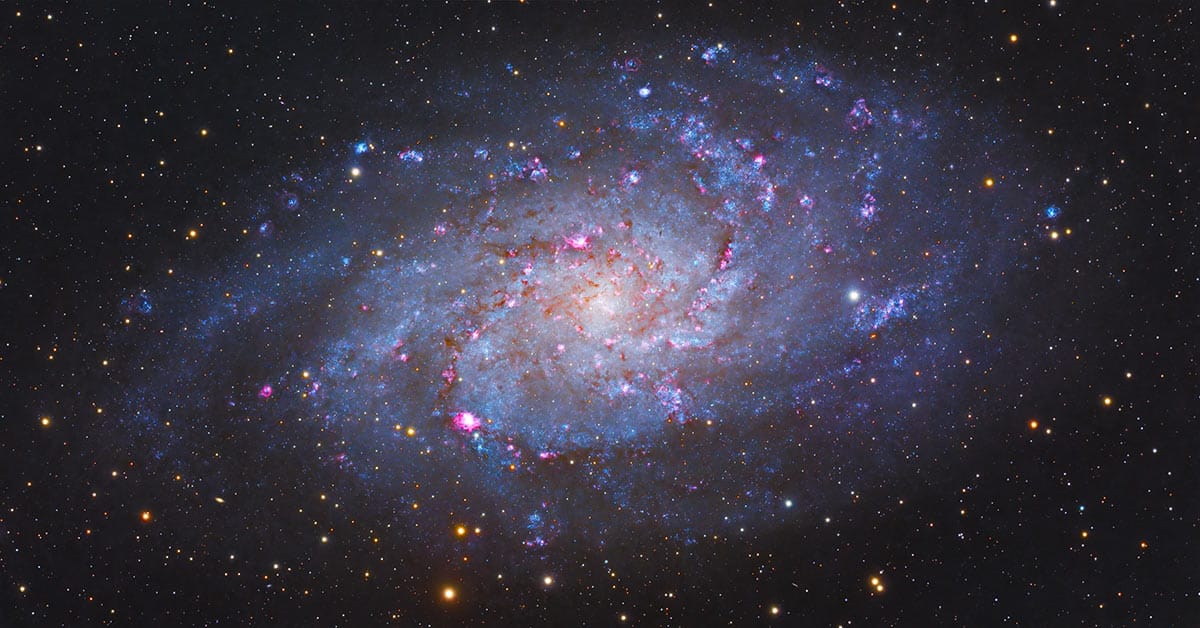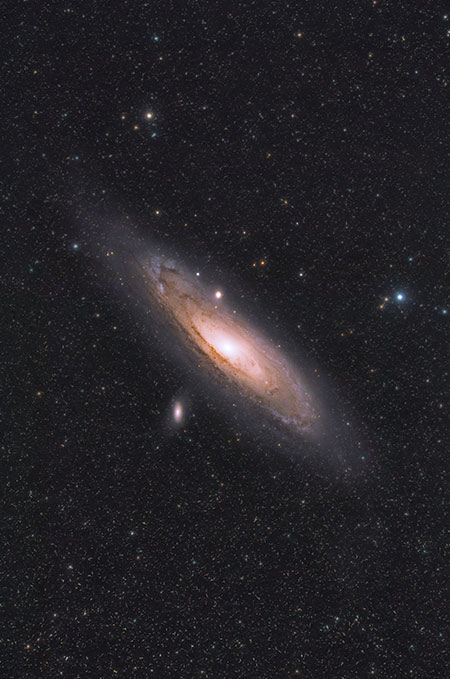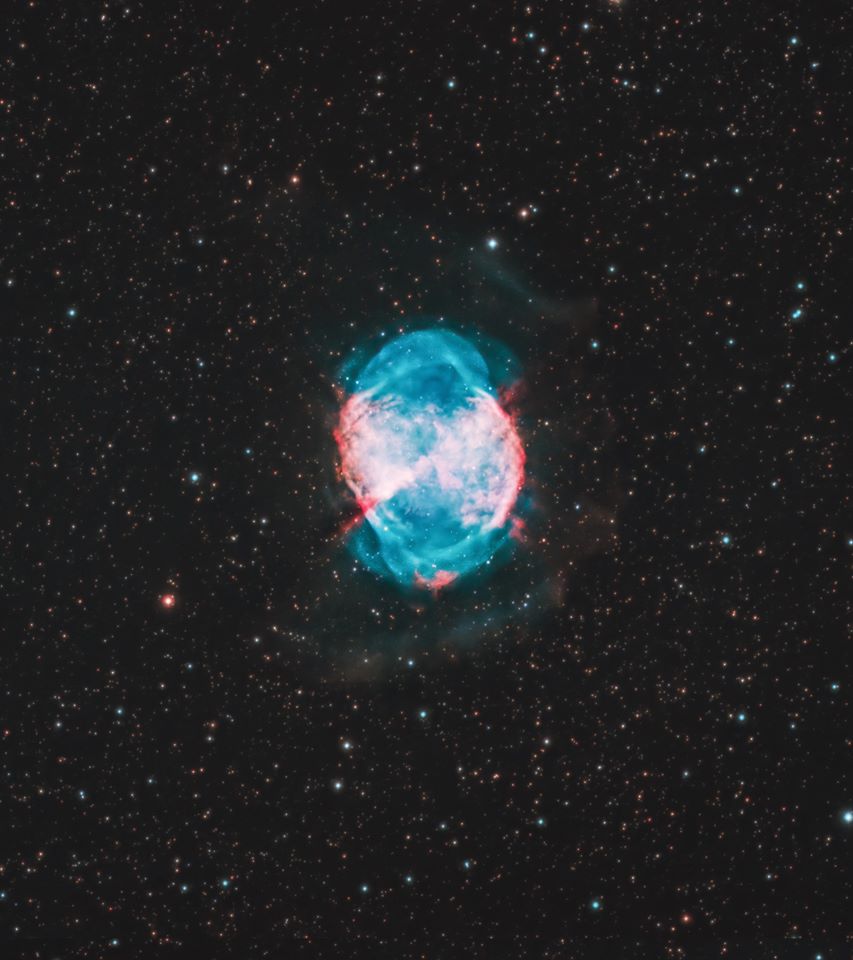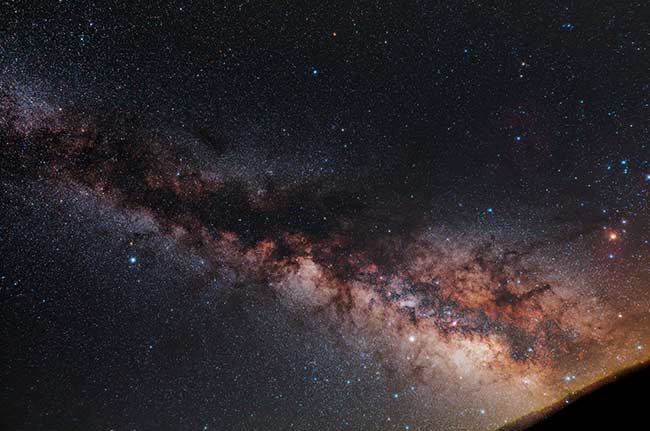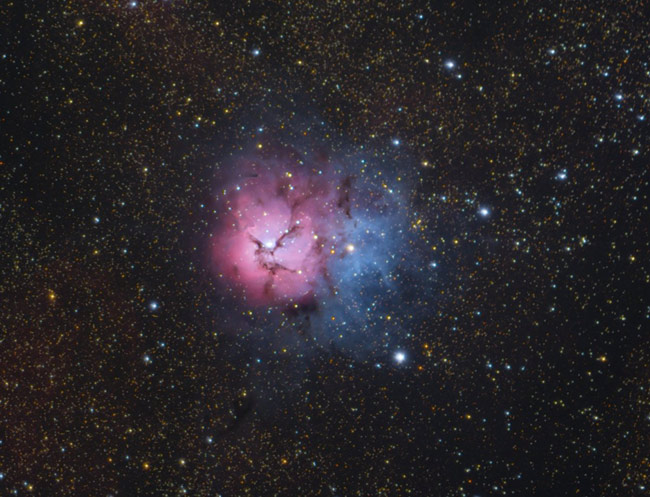Learn Astrophotography
If you are looking to learn astrophotography and the process of capturing deep-sky objects with your DSLR and telescope, you may find the information below of value. By watching my techniques from the backyard, you will understand how to go about capturing images yourself.
No matter your current skill level in astrophotography, you can always pick up a few pointers by watching a fellow astrophotographer’s workflow. Actions speak louder than words. If you have seen the deep-sky images in my photo gallery, then you know what to expect when using my capturing and processing methods.
Deep Sky Astrophotography is a Lifelong Journey. Enjoy every step of the way.
The AstroBackyard blog has been running since 2015, so I decided to assemble some of the most useful information in one place. The archived articles below act as a beginner’s guide to learning astrophotography. I have grouped each blog post by topic, to help you get started.
The Triangulum Galaxy. Trevor Jones
Before diving into the articles and tutorials below, make sure you have a look at the astrophotography equipment I use for deep-sky astrophotography, including the telescope and camera I use.
The resources and tutorial sections contain a wealth of information to help you along the way. You can also learn a lot by watching the videos on my YouTube channel, AstroBackyard.
Learn Astrophotography: Topics
For Beginners Only!
- Getting Started in Smartphone Astrophotography
- Deep-Sky Astrophotography How-To (Complete Walkthrough)
- 7 Astrophotography Tips (You Can Try Tonight)
- Astrophotography: How to Get Started
- How to Photograph the Orion Nebula (with a Camera Lens)
- AstroBackyard Image Processing Guide
The Northern Lights Dancing Above my Backyard.
Recommended Targets
- The Andromeda Galaxy
- The Orion Nebula
- The Eagle Nebula
- The Cave Nebula in Cepheus
- The Elephant’s Trunk Nebula in Duo-Narrowband
- The Lagoon Nebula with a DSLR and Telescope
- The Crescent Nebula in H-Alpha (DSLR)
- Markarian’s Chain of Galaxies
- The Leo Triplet – Springtime Trio of Galaxies
- The Ultimate Target for your DSLR and Telescope
- The Best Winter Deep-Sky Objects
- Photogenic Group of Galaxies
- The Ghost Nebula
The Andromeda Galaxy captured with a DSLR Camera and small telescope.
Image Processing Tutorials
- One-Shot-Color Narrowband Image Processing in PixInsight
- Complete Image Processing Tutorial in Adobe Photoshop
- Selective Color Boosting (Photoshop Tutorial)
- Topaz Labs DeNoise Review
- Use StarNet++ to Quickly Remove Stars from Your Image
- Andromeda Galaxy Image Processing Tutorial
- Use the Select and Mask Tool in Adobe Photoshop CC
- Create an HDR Image of the Orion Nebula
- How to Remove Gradients in Photoshop
- Deep Sky Image Processing in Photoshop
- The Horsehead Nebula in HaRGB
- Tutorial – Manual Stacking in Photoshop
- Introduction to H-Alpha Astrophotography
- Forgotten Light Frames – Processing Old Data
- The Importance of Screen Calibration
- Selective Processing in Photoshop for More Detail
- Deep Sky Stacker and Photoshop Tutorial
The Dumbbell Nebula
Camera Equipment
- ZWO ASI585MC Pro Astronomy Camera
- ZWO ASI2400MC Pro Camera Review
- Optolong L-eXtreme Filter Review
- Sky-Watcher Star Adventurer GTi Review
- Starlight Xpress CCD Cameras (Mono CCD)
- Canon EOS Ra Astrophotography Camera Review
- Sky-Watcher Star Adventurer Pro Review
- ZWO ASIair WiFi Camera Control Device
- ZWO ASI294MC Pro Color Camera Review
- New Canon Clip In Astrophotography Filter
- How a DSLR Ha Filter can Improve Your Astrophotos
- Astrophotography with a Canon Rebel DSLR
- Altair Astro GPCAM2 AR0130 Mono CCD for Autoguiding
- Camera Mount Review: The iOptron SkyGuider Pro
- Astronomik 12nm Ha Filter
- iOptron SkyTracker Pro Camera Mount
- Recommended Light Pollution Filters
The Milky Way
Telescope Equipment
- Choosing Binoculars for Astronomy and Stargazing: A Guide
- Astrophotography Mounts (Best Models From Beginner to Pro)
- The Best Telescope for Astrophotography in 2024
- William Optics RedCat 61 Review
- ZWO AM5 Astrophotography Mount Review
- ZWO SeeStar S50 Review
- Celestron StarSense Explorer Dob Review
- Celestron NexStar 8SE Telescope Review
- William Optics Pleiades 68 WIFD Review
- Celestron StarSense AutoAlign Review
- Sky-Watcher EQ6-R Pro SynScan Review
- The Celestron 8-inch RASA F2 (Review)
- QHY PoleMaster Electronic Polar Scope Review
- Choosing a Telescope Mount for Astrophotography
- Sky-Watcher Esprit 100 ED Super APO Triplet Unboxing (video)
- Explore Scientific ED140 – First Impressions –
- Meade 70mm Quadruplet ED APO Astrograph Review
- iOptron CEM60 Astrophotography Mount – First Look
- William Optics Z61 APO Review
- The Best Beginner Astrophotography Telescope
- My New Astrophotography Telescope
- Aligning My Newtonian – Reflector Collimation Tips
- How to Use a Bahtinov Focus Mask
- My Complete Deep-Sky Imaging Setup
The Trifid Nebula
Backyard Imaging Tips
- Summer in the AstroBackyard
- Astrophotography in the City
- Can you image deep-sky objects during a full moon?
- 5 Tips for Better PHD2 Guiding
- How to take Flat Frames for Astrophotography
- Deep Sky Astrophotography Walkthrough (Step-by-Step)
- How to Take Dark Frames for Astrophotography
- How to Attach Your Camera to a Telescope
- What’s the Difference Between Tracking and Guiding?
- How to Take Bias Frames for Astrophotography
- How to Focus Your Camera for Astrophotography
Celestial Events
- How to Photograph a Solar Eclipse
- How To Watch The Perseid Meteor Shower
- How to Photograph a Total Lunar Eclipse
- Types of Solar Eclipses
- Delta Aquarid Meteor Shower
- Landscape Astrophotography 5 Visible Planets
Traveling with your Astrophotography Gear
- Comparing Images Captured from the City vs. a Dark Sky
- The Okie-Tex Star Party (What to Expect)
- The Dark Skies of the Cherry Springs Star Party
- Starfest is Canada’s Biggest Star Party
- Photographing the Carina Nebula from Costa Rica
- The Best Portable Astrophotography Setup
- Finding Darker Skies – Camping Under the Stars
Solar System Photography
- What Venus Looks Like Through a Telescope
- How to Photograph the Planets (with any camera)
- Photographing the 2016 Harvest Moon
- Moon Photography Tips – Christmas Eve Moon
- How To Photograph the Planet Jupiter
- How To See Saturn Through a Telescope
Camera Lens Astrophotography (Wide-Field)
- Using the Sigma 24mm F/1.4 Lens for Astrophotography
- The Rokinon 135mm F/2 was built for astrophotography
- Using a Canon EF 24-105mm Lens for Astrophotography
- Deep Sky Astrophotography with a 300mm Camera Lens
- Real Results with a Budget Astrophotography Lens
- The Perseus Double Cluster with a 300mm Lens
All of the information contained on this page was discovered from real-life experiences in the backyard! Astrophotography is a learning process that never ends. The exciting part is, that the more you learn, the better your photos become.
My dream is to one day build a backyard observatory in a dark sky location. Perhaps that dream will become a reality by utilizing the same passion and work ethic involved in building AstroBackyard.com.
Clear Skies. – Trevor
